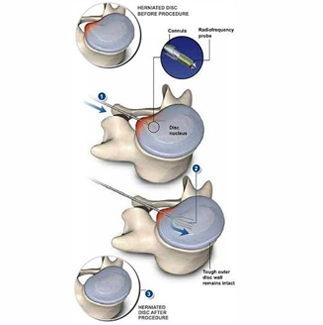

Nucleoplasty
Nucleoplasty is a means of reducing the production of breakdown products within the disc which may be irritant when it leaks through the disc wall and on to adjacent structures such as the Posterior Longitudinal Ligament or nearby nerves.
Nucleoplasty is a means of reducing the production of breakdown products within the disc which may be irritant when it leaks through the disc wall and on to adjacent structures such as the Posterior Longitudinal Ligament or nearby nerves.
The technique utilises "cool" radiofrequency to interupt the production of these products and to gradually effect a reduction in a disc wall bulge.
It is used for soft broad based bulges of the disc where the disc is in an early stage of degeneration.
The best candidate for this procedure is one who suffers from a contained disc herniation that has not responded to conservative care. Typical signs of a contained disc herniation are primary pain radiating down the leg or arm accompanied by some back pain. Nucleoplasty is not useful for degenerative disc disease or spinal fractures.
Nucleoplasty is a minimally invasive procedure that allows the patient to go home the day of the procedure with only a small bandage on their back. The procedure is performed by specialties including pain management, physiatry, interventional radiology, and surgeons using x-ray guidance to accurately place a needle in the disc, much like an epidural steroid injection. A patented plasma device is then inserted through the needle into the disc, where excess tissue is removed. Similar to letting air out of a bicycle tire, removing some of the tissue from the center of a disc causes a reduction in disc pressure, which in turn, eases symptoms.
Targeted Disc Decompression
TDD is for discogenic low back pain. When procedure is performed, there is a shrinkage effect on collagen and intradiscal pressure changes. TDD is a thermocoagulationtechnique, the degree of hydration of the nucleus is, in principle, not important.
The device is designed to allow direct access to herniated disc material and vaporizes the herniated nucleus using bipolar radiofrequency current similar to Nucleoplasty. In contrast to the Nucleoplasty device, the Wand can be curved and directed into a disc herniation.
Patients with herniated nucleus pulposus related to radicular pain are benifited with this technique.


